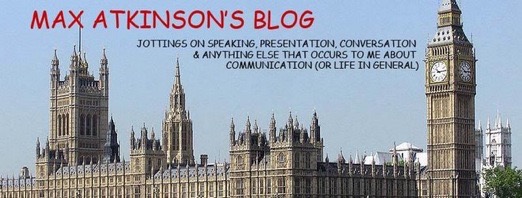Regular readers will realise why, given my regular posts on the peculiar times and places selected by today's politicians (see below), I was greatly frustrated by yesterday's news headlines being dominated by a former Conservative prime minister making what the Daily Mail described as a 'wide ranging and passionate speech' to a real audience in a suitable location - without any media camera crews being present.
So you can't see it on YouTube or anywhere else, and, for once, all we can do is look at are those parts of it that were quoted in the media, such as this from the Daily Mail.
Improved mastery of rhetoric and imagery?
Compared with what I wrote in 1993 ('Majorspeak: observations on the prime minister's style of speaking'), some of which is touched on in the above video clip, there was some evidence that his command of rhetoric and imagery has improved - probably because of his experience on the lucrative US speaker circuit in the years since he left office.
There were, for example, some impressive contrasts:
"Governments should exist to protect people, not institutions"
The Conservative Party "is at its best when it is tolerant and it is open and at its worst when it's hectoring and censorious"
He said it was wrong that so many families would have to choose between keeping warm and eating this winter.
There was at least one three-part list in which the third item contrasted with the first two:
"and it is very easy, criminally easy, to overlook these silent citizens, they don't demonstrate, they don't make a fuss, they just get in with their lives.
There was a puzzle with a 3 part list in the solution":
"How do I know about these people? Because I grew up with them. they were my neighbours, the silent have-nots."
He also made some interesting use of imagery:
"If we Tories only navel gaze and only pander to our comfort zone, we will never win general elections. All the core delivers is the wooden spoon."
Majorspeak revisited?
An observation at the time of the 1992 general election was John Major's tendency to speak very 'formally' (See Chapter 19, Crew & Gosschalk, 1995). This was evidenced partly by his choice of words that are rarely, if ever, heard in everyday conversation (e.g. 'whomsoever', 'wayside inn', 'on the morrow', badinage, etc.) and partly by his reluctance ever to use the elided forms for negatives and certain tense constructions (e.g. he was more likely to say 'we do not' than 'we don't', 'we had' rather than we'd' etc.
In yesterday's speech, "hectoring" and "censorious" suggest that his preference for obscure words lives on.
But the fact that he said "they don't" twice in quick succession is perhaps evidence that he has started to break away from his former preference for using the full forms.
The bad news is that, without the video-taped evidence, we may never know.
Related Posts:
